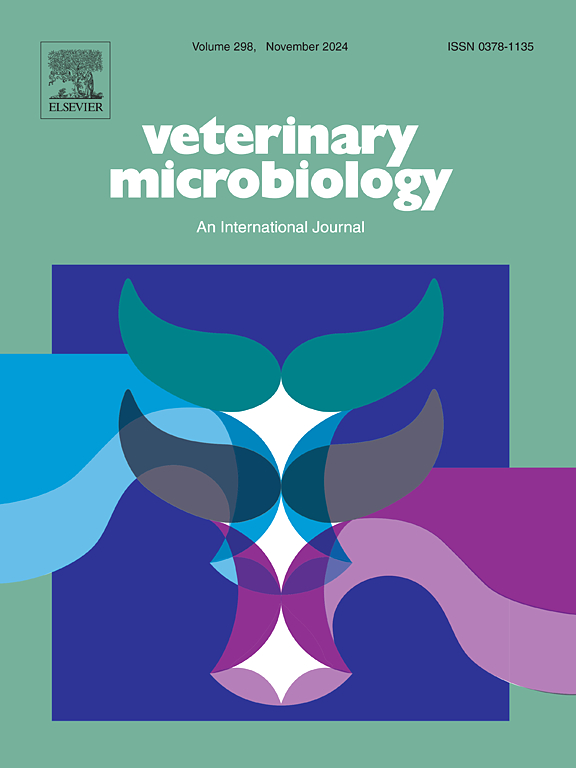Tracking of single virus: Dual fluorescent labeling of pseudorabies virus for observing entry and replication in the N2a cells
IF 2.4
2区 农林科学
Q3 MICROBIOLOGY
引用次数: 0
Abstract
Pseudorabies virus (PRV) is a neurotropic herpesvirus. It is not easy to be track the whole replication progress of PRV, especially the nascent viral genome in the host cells. In this study, we developed a dual-fluorescence-labeled PRV (rPRV-Anchor3-mCherry) with the viral genome and the envelope protein gM labeled by ANCHOR DNA labeling system and mCherry, respectively. Through single-virus tracking of rPRV-Anchor3-mCherry, we observed that PRV invaded mouse neuroblastoma Neuro-2a cells via both endocytosis and plasma membrane fusion pathway. During the replication stage, parental and progeny viral genome of rPRV-Anchor3-mCherry in the cell nuclei could be visible, and viral nucleocapsid appeared more specifically than traditional capsid protein labeled PRV particles (rPRV-VP26-EGFP). We found that numerous progeny viral particles were produced in the nuclear, causing the nucleus membrane to break using three-dimensional (3D) live-cell imaging and electron microscopy. Moreover, our findings confirmed that simultaneously targeting of the UL9 and UL54 genes using a CRISPR-Cas9 system led to the complete inhibition PRV replication. rPRV-Anchor3-mCherry can be used to research multiple steps of the viral cycle.
单个病毒的追踪:伪狂犬病毒的双荧光标记,用于观察N2a细胞的进入和复制
伪狂犬病毒(PRV)是一种嗜神经疱疹病毒。想要追踪PRV的整个复制过程,尤其是在宿主细胞中追踪新生病毒基因组的复制过程是不容易的。在这项研究中,我们开发了一种双荧光标记的PRV (rPRV-Anchor3-mCherry),病毒基因组和包膜蛋白gM分别被ANCHOR DNA标记系统和mCherry标记。通过对rPRV-Anchor3-mCherry的单病毒追踪,我们观察到PRV通过内吞和质膜融合途径侵入小鼠神经母细胞瘤神经-2a细胞。在复制阶段,细胞核内可见rPRV-Anchor3-mCherry亲代和子代病毒基因组,病毒核衣壳比传统衣壳蛋白标记的PRV颗粒(rPRV-VP26-EGFP)更具特异性。利用三维(3D)活细胞成像和电子显微镜,我们发现在细胞核中产生了许多子代病毒颗粒,导致核膜破裂。此外,我们的研究结果证实,使用CRISPR-Cas9系统同时靶向UL9和UL54基因可以完全抑制PRV的复制。rPRV-Anchor3-mCherry可用于研究病毒周期的多个步骤。
本文章由计算机程序翻译,如有差异,请以英文原文为准。
求助全文
约1分钟内获得全文
求助全文
来源期刊

Veterinary microbiology
农林科学-兽医学
CiteScore
5.90
自引率
6.10%
发文量
221
审稿时长
52 days
期刊介绍:
Veterinary Microbiology is concerned with microbial (bacterial, fungal, viral) diseases of domesticated vertebrate animals (livestock, companion animals, fur-bearing animals, game, poultry, fish) that supply food, other useful products or companionship. In addition, Microbial diseases of wild animals living in captivity, or as members of the feral fauna will also be considered if the infections are of interest because of their interrelation with humans (zoonoses) and/or domestic animals. Studies of antimicrobial resistance are also included, provided that the results represent a substantial advance in knowledge. Authors are strongly encouraged to read - prior to submission - the Editorials (''Scope or cope'' and ''Scope or cope II'') published previously in the journal. The Editors reserve the right to suggest submission to another journal for those papers which they feel would be more appropriate for consideration by that journal.
Original research papers of high quality and novelty on aspects of control, host response, molecular biology, pathogenesis, prevention, and treatment of microbial diseases of animals are published. Papers dealing primarily with immunology, epidemiology, molecular biology and antiviral or microbial agents will only be considered if they demonstrate a clear impact on a disease. Papers focusing solely on diagnostic techniques (such as another PCR protocol or ELISA) will not be published - focus should be on a microorganism and not on a particular technique. Papers only reporting microbial sequences, transcriptomics data, or proteomics data will not be considered unless the results represent a substantial advance in knowledge.
Drug trial papers will be considered if they have general application or significance. Papers on the identification of microorganisms will also be considered, but detailed taxonomic studies do not fall within the scope of the journal. Case reports will not be published, unless they have general application or contain novel aspects. Papers of geographically limited interest, which repeat what had been established elsewhere will not be considered. The readership of the journal is global.
 求助内容:
求助内容: 应助结果提醒方式:
应助结果提醒方式:


